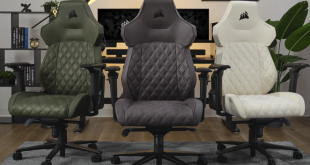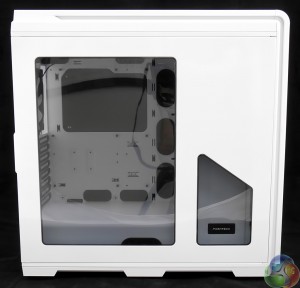
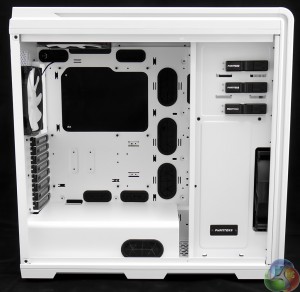
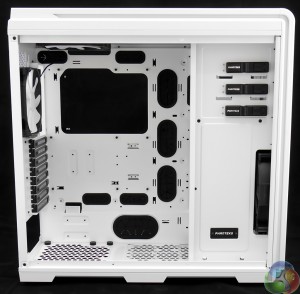
Removing the windowed side panel opens up the interior of the case and blimey it's bright and white inside. Removing three thumb screws allows you to pull out the power supply cover to leave the case ready for the system build.
[yframe url='http://www.youtube.com/watch?v=zWhwxdKFQs8′]
Here's a short video clip from another angle to show the amount of space inside the Enthoo Luxe with a clearer view of the two 140mm fans in the upper rear corner of the case.
As you can see there is plenty of space around the motherboard to make your PC build as easy as possible. There are massive holes for cable management with grommets that keep the cables nice and tidy. Naturally there is a huge opening to give access to the back of the motherboard so you can be confident you'll have the minimum of hassle installing your chosen CPU cooler.
What you cannot tell from the photos and video is that the Enthoo Luxe is manufactured from a variety of materials.
The main chassis, interior fittings and two side panels are made from steel. Phanteks makes the point that the structure of the Luxe is mod friendly as the components are fastened together with screws, instead of the usual rivets.
If you plan on modifying the Luxe you can remove the top of the case along with the optical drive bay and hard drive tower. The top and front panels are plastic and pop into the top and front of the chassis using a set of mounting posts. These panels require a firm pull to remove them from the case and once they are free (albeit hanging on their cables) it is all too easy to lay them to one side without paying them close attention. In fact these ‘plastic' panels are faced with painted aluminium panels that measure some 2mm thick.
I struggled to spot how Phanteks has engineered the Luxe merely by using my eyes but when I ran my fingers across the panels I could feel the aluminium parts were cool to the touch.
It is a shame that a great deal of tooling and clever work with materials will escape most people's attention but we are interested in results, rather than process. The result of this approach is a painted finish that looks superb whilst also avoiding the curse of greasy fingerprints. I suggest you put the thought of aluminium out of your mind and simply admire the finished result which is gorgeous.
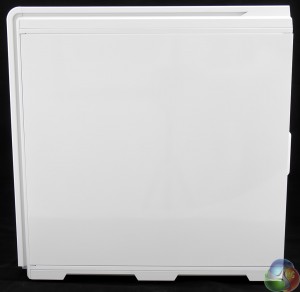
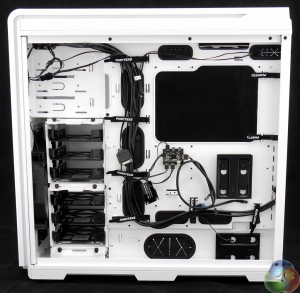
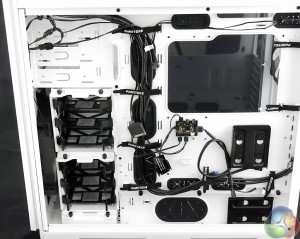
Turning to the other side of the case we have the side panel which is smooth and unblemished. Remove two thumbscrews, lift away the cover and you'll see a whole host of features. There are eight hook and loop straps for cable management, two single bay Drop-n-Lock SSD brackets and a PWM hub to manage your fan connections.
Mixed in with the bundle of cabling you might spot a couple of SATA power connectors. One powers the PWM hub while the other feeds juice to the lighting system.

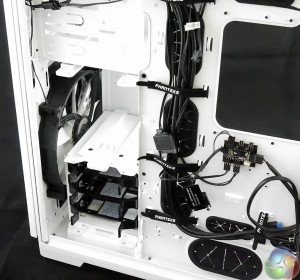
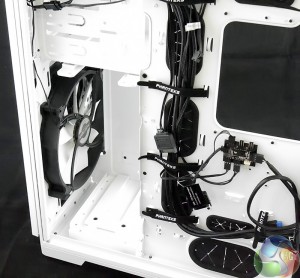
At the front of the case, directly behind the 200mm case fan, there are six 3.5-inch drive bays that are stacked in two towers, one on top of the other. If you don't plan on using a bunch of high capacity drives it is simple to remove the towers and that helps air flow through the front of the case to an admirable extent.
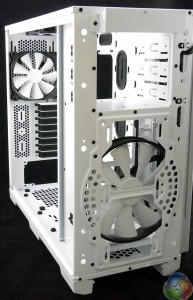
This photo of the Enthoo Luxe shows the case stripped of the side, top and front panels and shows the path of the airflow through the case from the massive 200mm fan at the front to the two 140mm fans at the rear.
 KitGuru KitGuru.net – Tech News | Hardware News | Hardware Reviews | IOS | Mobile | Gaming | Graphics Cards
KitGuru KitGuru.net – Tech News | Hardware News | Hardware Reviews | IOS | Mobile | Gaming | Graphics Cards


